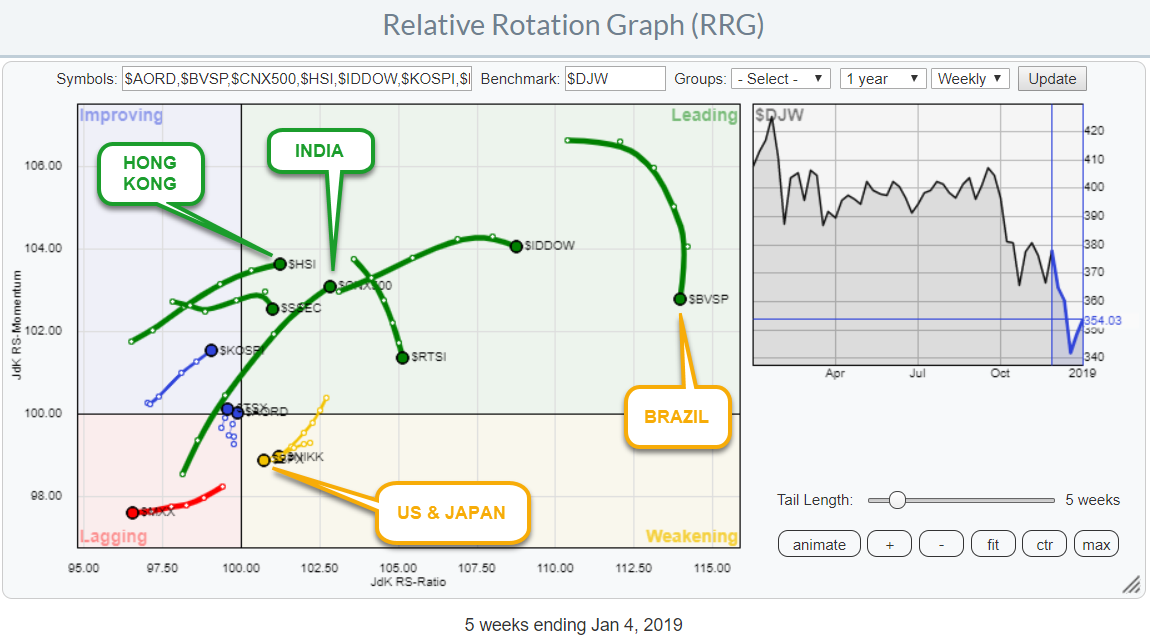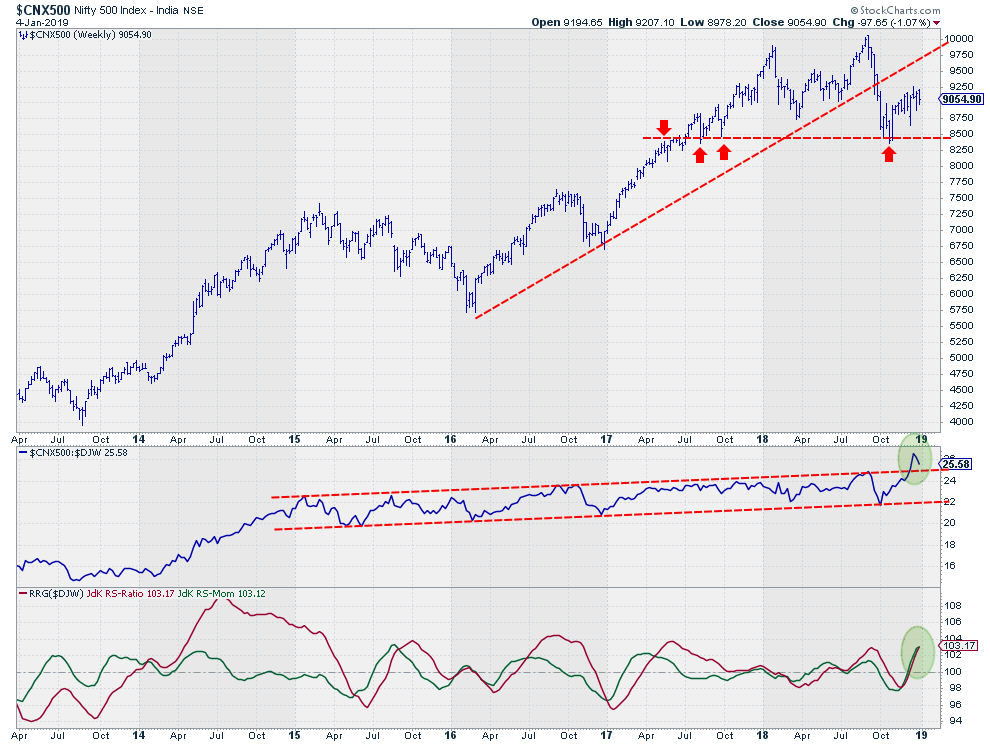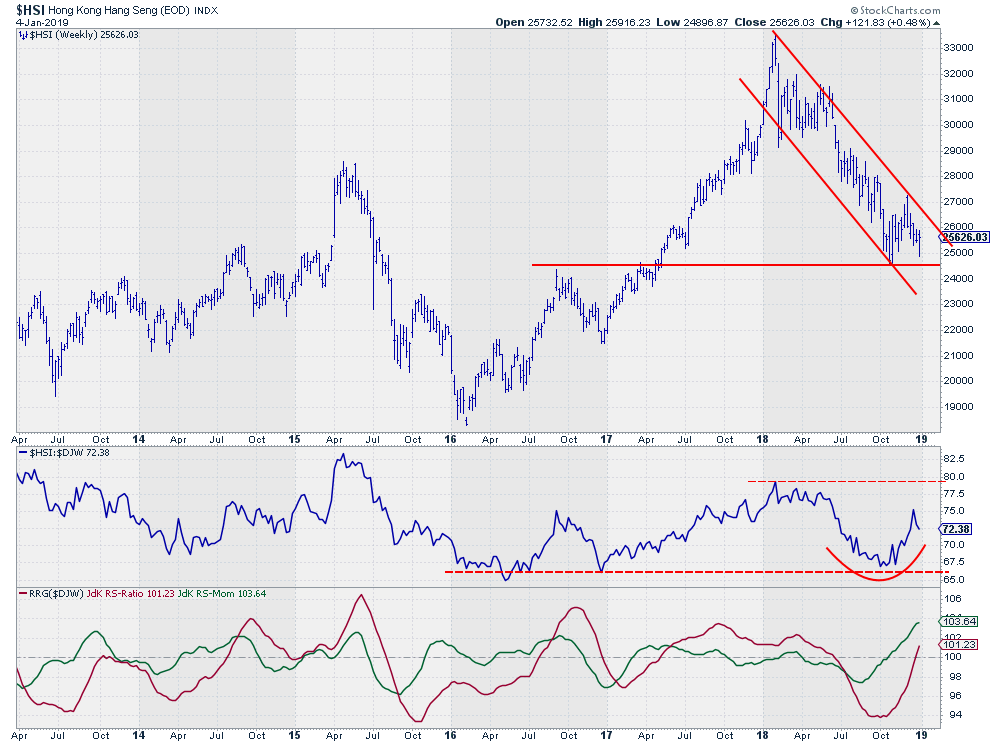 With the US stock market declining investors (may) need to look for alternatives in order to preserve capital. Sure enough, there are good opportunities in the US with bonds, IEF is doing very well, and cash is a very viable alternative if you do not "need" to be invested.
With the US stock market declining investors (may) need to look for alternatives in order to preserve capital. Sure enough, there are good opportunities in the US with bonds, IEF is doing very well, and cash is a very viable alternative if you do not "need" to be invested.
If you are in a position where you do need to be invested in stocks or you want to keep an allocation to stocks in your portfolio, even if it is an underweight position, you might need to look outside the US for alternatives.
The Relative Rotation Graph above shows the rotation for some major stock market indices around the world. The benchmark is the Dow Jones Global Index ($DJW).
There are a few tails that stand out on this plot. These are the $CNX500 for India and the $HSI for Hong Kong which both just entered the leading quadrant at a positive RRG-Heading and $BVSP which is far away to the right of the canvas and rolling over towards the weakening quadrant.
As a reference, the US market ($SPX) is rotating inside the weakening quadrant and heading towards lagging (negative RRG-Heading).
India
In the past six months, this market rotated from leading through weakening and lagging back into leading again. Especially the fact that the distance between the observations is increasing in the most recent part of the tail, indicates relative strength behind the move.
 A look at the price chart of $CNX500 in combination with relative strength against $DJW shows a break of relative strength out of a multi-year marginally upward sloping channel. This break is now supported by both RRG-Lines rising sharply above 100 pushing $CNX500 rapidly further into the leading quadrant making it one of the stronger stock markets from a relative perspective.
A look at the price chart of $CNX500 in combination with relative strength against $DJW shows a break of relative strength out of a multi-year marginally upward sloping channel. This break is now supported by both RRG-Lines rising sharply above 100 pushing $CNX500 rapidly further into the leading quadrant making it one of the stronger stock markets from a relative perspective.
Support for $CNX500 has been established a few weeks ago near 8.450 while there is still some upward potential towards the former rising support line.
Hong Kong
 After a strong start, the Hong Kong stock market spent all of 2018 in a falling trend channel. This downtrend was caught by support at 24.500 in the second half of October. Out of the newly formed low a rally emerged which topped against the falling resistance line just above 27.000.
After a strong start, the Hong Kong stock market spent all of 2018 in a falling trend channel. This downtrend was caught by support at 24.500 in the second half of October. Out of the newly formed low a rally emerged which topped against the falling resistance line just above 27.000.
At the moment $HSI is coming off that peak again and on its way to support near 24.500. That area seems important as it is also the area where the market peaked in September 2016 and March 2017 before breaking higher and embarking on its journey towards the high at 33.500.
As a side note, I am not a big user, nor an expert, of Fibonacci analysis but it happens to be the 61.8% retracement of the 2016-2017 rally.
Given the fact that markets like $SPX have broken below their late 2018 support levels, $HSI is jumping in relative strength with the RS-Line against $DJW turning around and RRG-Lines steeply rising above 100. Together with India, this is likely to be one of the stronger stock markets at the beginning of this year.
Brazil
 The Brazilian Bovespa index very recently broke to new highs. A picture completely different from most stock markets at the moment.
The Brazilian Bovespa index very recently broke to new highs. A picture completely different from most stock markets at the moment.
Its relative strength started to show at the end of October when the RS-Line broke to new highs followed by the JdK RS-Ratio line crossing above the 100-level which pushed the market into the leading quadrant.
During the Q4-2018 turmoil, Brazil managed to keep up and just recently even managed to break to new highs in price.
With a number of major markets recovering somewhat from their recent losses the relative strength for Brazil is rolling over now. However, given the position on the RRG, far away to the right at very high RS-Ratio levels, this seems more of a breather within a strong relative uptrend rather than the end.
The area around 87.500 seems to be a good support level to watch now.
Create Exposure Through ETFs But Beware Of The Currency Risk
You can create exposure to these international stock markets by using ETFs. For example, for India, you can use INDA, for Hong Kong EWH and for Brazil EWZ. Just search country name +ETF in the Stockcharts database and various tickers will show up.
Just be aware of the currency risk when you invest in these ETFs. These ETFs are quoted in US dollars while their underlying markets are NOT!!! The price of the ETF, the thing you're actually buying is the price of the index times the USD exchange rate for the country's currency. This can have a big impact on your returns measured in USD.
Currency risk is nothing to be scared of but it is something you need to be aware of and it means that you always have TWO decisions to make when you decide to invest abroad #justsaying
My regular blog is the RRG blog If you would like to receive a notification when a new article is published there, simply "Subscribe" with your email address using the form below.
Julius de Kempenaer | RRG Research
RRG, Relative Rotation Graphs, JdK RS-Ratio, and JdK RS-Momentum are registered TradeMarks ®; of RRG Research
Follow RRG Research on social media:
Feedback, comments or questions are welcome at Juliusdk@stockcharts.com. I cannot promise to respond to each and every message but I will certainly read them and where reasonably possible use the feedback and comments or answer questions.
If you want to discuss RRG with me on SCAN, please use my handle Julius_RRG so that I will get a notification.
